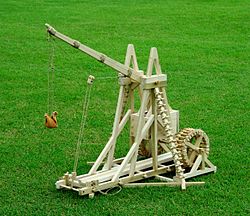

The Warwolf, also known as the Loup-de-Guerre or Ludgar, [1] is believed to have been the largest trebuchet ever made. [2] It was created in Scotland by order of Edward I of England, during the siege of Stirling Castle in 1304, as part of the Wars of Scottish Independence. A contemporary chronicle refers to it as une engine orrible. [3]